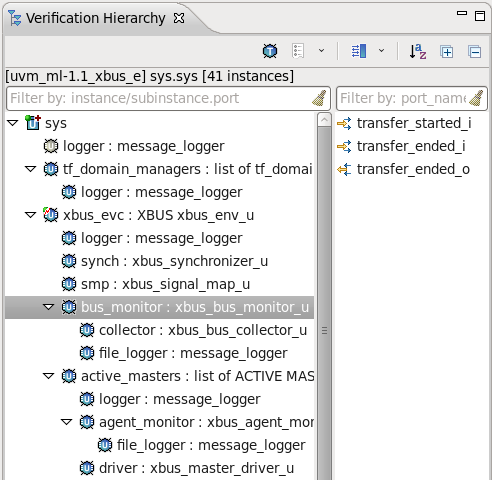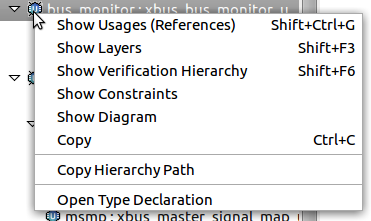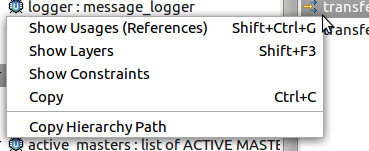UVM Verification Hierarchy
The Verification Hierarchy View presents the unit instance tree.
Position the editor cursor on the name of a unit and press Shift+F6 or right-click and choose from the context menu.
The Verification Hierarchy View opens with the chosen unit set as the top of the hierarchy. You can also go to to open the view.

 Select Top drop-down menu/pop-up dialog to select from top units. By default, tops are considered all units that instantiate other units and are not themselves instantiated, such as the unit sys. You can specify the list of tops in the project’s build configuration using the directive +dvt_e_vtop+”pkg_name::SUBTYPE unit_name”.
Select Top drop-down menu/pop-up dialog to select from top units. By default, tops are considered all units that instantiate other units and are not themselves instantiated, such as the unit sys. You can specify the list of tops in the project’s build configuration using the directive +dvt_e_vtop+”pkg_name::SUBTYPE unit_name”. History List Click to see the previously inspected tops.
History List Click to see the previously inspected tops. Show/Hide Ports Shows or hides the ports of the selected unit. You can set the ports panel to the right or below the hierarchy.
Show/Hide Ports Shows or hides the ports of the selected unit. You can set the ports panel to the right or below the hierarchy. Alphabetical Sort Sort instances and ports alphabetically. By default it is off, which means that the instances and the ports are presented in their declaration order from the source files.
Alphabetical Sort Sort instances and ports alphabetically. By default it is off, which means that the instances and the ports are presented in their declaration order from the source files.
The view label shows the current project, the current top unit and the number of instances in the hierarchy.

You can double-click on any unit or on any port to go to its declaration.
Right-click on a unit instance in the hierarchy and you have the following options :

Show Usages (References) Search for the references of the selected instance. More details Search for References (Usages, Readers or Writers)
Show Layers Show the layers of the selected instance. More details Layers View.
Show Type Hierarchy Show the type hierarchy for the selected instance type. More details Type Hierarchy View.
Show Verification Hierarchy Set the selected instance as the top of the hierarchy and update the view.
Show Diagram Generate the UVM Component Diagram of the selected instance. More details UVM Components Diagrams.
Copy Copy the label text of the selected instance to clipboard.
Copy Hierarchy Path Copy the hierarchy path of the selected instance to clipboard. You can change the segment separator from .
Open Type Declaration Go to the unit declaration of the selected instance.
Right-click on a port and you have the option to search for its usages or for its layers and show the constraints, also you can copy its name and the full hierarchy path of the selected port.

You can use the filters to locate a specific instance or port. You may use slash ‘/’ characters to filter hierarchically one level and ‘//’ to filter hierarchically all the levels. You may use the dot ‘.’ character to filter instances that contain a specific port. See Quick Search in Views for more details.
For example, filtering hierarchically all the levels for a specific port name :
